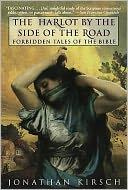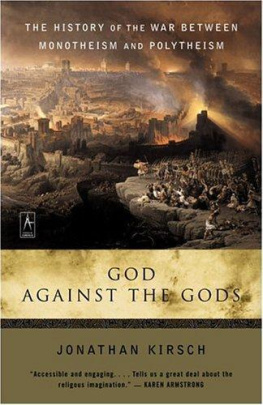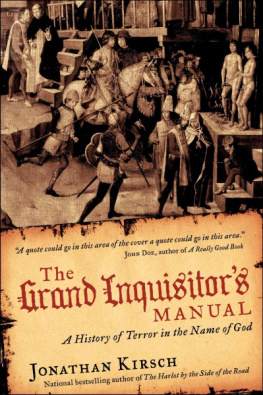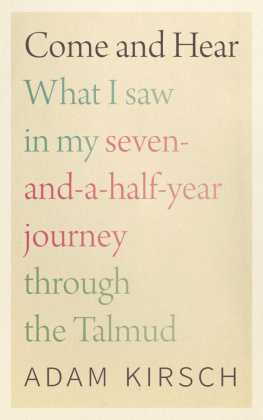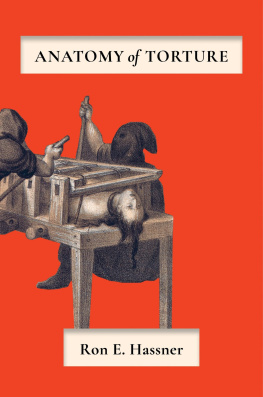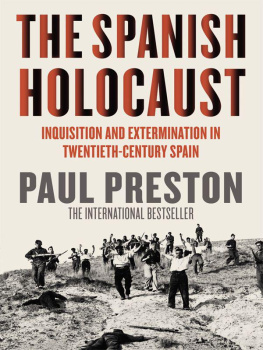I was torn in pieces by the devils that rack the brains of unhappy men. Do Gods eyes not reach to the prisons of the Inquisition?
Christendom seemed to have grown delirious and Satan might well smile at the tribute to his power in the endless smoke of the holocaust which bore witness to the triumph of the Almighty.
HENRY CHARLES LEA,
A History of the Inquisition of the Middle Ages
L et us imagine a traveler arriving in the city of Rome when the Renaissance was in full flower, a pilgrim or a merchant or a diplomat. He seeks out the chapel near St. Peters Basilica where the Piet of Michelangelo is now on display, and he spends a few moments admiring the sublime depiction of the body of the slain Jesus in the lap of his grieving mother. Piet means pity, and the scene is rendered with exquisite tenderness and profound compassion. Like Michelangelos frescoes on the ceiling of the nearby Sistine Chapelthe finger of a very fleshy God touching the finger of an equally fleshy Adamthe Piet celebrates the beauty, dignity, and grace of the human body and the most exalted emotions of the human heart.
At the very same moment, however, and not far away, hooded men in dungeons lit only by torcheshenchmen of what would come to be called
The scene allows us to see the Renaissance and the Inquisition as a pair of opposites, the highest aspirations of human civilization coexisting with its darkest and most destructive impulses at the same time and place. Tragically, the genius that Michelangelo applied to the celebration of the human body is matched by the ingenuity of the grand inquisitors in their crusade to degrade and destroy their fellow human beings. Consider, for example, the contrivance known simply and even charmingly as La Pera the Pear.
Fashioned out of bronze, richly and fancifully decorated, and cunningly engineered to open and close by the operation of an iron key-and-screw device, the Pear was the handiwork of a skilled artist and craftsman with a vivid imagination and a certain measure of wit. The first examples of the Pear date back to roughly the same era as the Piet. But unlike the scene depicted in Michelangelos statuary, the diabolical faces and demonic figures that embellish La Pera are the stuff of nightmares, and the object itself was designed as an instrument of torture to afflict the bodies of accused heretics who refused to confess, whether because they were wholly innocent of the accusation or because they were true believers in their own forbidden faith.
Exactly how the Pear was used to insult and injure its victims is a gruesome topic that we will be compelled to examine in greater detail a bit later. For now, let La Pera serve as a symbol of the willingness, even the eagerness of one human being to inflict pain on a fellow human being. None of us should be surprised, of course, that otherwise ordinary men and women have always been capable of heart-shaking and heartbreaking atrocities, but the fact that a man with the soul of an artist and the hands of a craftsman should apply his gifts to the creation of something as fiendish as the Pear reveals something dire and disturbing about how we use the gifts we have inherited from our distant art- and toolmaking ancestors.
An even more sinister irony is at work here. What the men in black did to their victims with such tools was not a crime. To the contrary, when they tortured and killed countless thousands of innocent men, women, and children, they were acting in obedience toand, quite literally, with the blessing ofthe most exalted guardians of law and order. Significantly, the official seal of the Inquisition carried the Latin phrase MISERICORDIA ET JUSTITIA (Mercy and Justice), and all the atrocities of the friar-inquisitors were similarly veiled in pieties and legalisms.
Here begins something new in history, an international network of secret police and secret courts in the service of Throne and Altar, a bureaucracy whose vast archives amounted to the medieval version of a database, and an army of inquisitors whose sworn duty was to search out anyone and everyone whom a pope or a king regarded as an enemy, sometimes on the flimsiest of evidence and sometimes on no evidence at all except the betrayals and confessions that could be extracted under torture and threat of death. The worst excesses of the agents of the Inquisitionpriests and monks, scribes and notaries, attorneys and accountants, torturers and executionerswere excused as the pardonable sins of soldiers engaged in war against a treacherous and deadly enemy.
The strange story of the Inquisition begins in the distant past, but it cannot be safely contained in history books. The inquisitorial apparatus that was first invented in the Middle Ages remained in operation for the next six hundred years, and it has never been wholly dismantled. As we shall see, an unbroken thread links the friar-inquisitors who set up the rack and the pyre in southern France in the early thirteenth century to the torturers and executioners of Nazi Germany and Stalinist Russia in the midtwentieth century. Nor does the thread stop at Auschwitz or the Gulag; it can be traced through the Salem witch trials in the Massachusetts Bay Colony, the internment of Japanese-Americans during World War II, the Hollywood blacklists of the McCarthy era, and even the interrogation cells at Abu Ghraib and Guantnamo.
Another instrument of torture, far less ornate but no less effective than La Pera, provides the best evidence that the inquisitors tools are still in use today. Among the first and favorite forms of torture used by medieval inquisitors was the so-called ordeal by water, that is, pouring water down a victims throat to simulate the sensation of drowning and thereby extract a confession. As far as the Inquisition was concerned, the ordeal by water was an ideal method of interrogation: it required only a bucket of water and a funnel, it left no telltale marks and no bloody mess to clean up, and yet it produced such agony and terror that the victim would readily tell the torturer whatever he wanted to hear. Thats why the ordeal by water was favored not only by the medieval inquisitors but also by their successors in the Gestapo and the Soviet secret police. And the same form of torture is still in use today, although we are asked by its modern users and defenders to call it waterboarding.
Nowadays, we tend to regard the Inquisition as an object of parody. Indeed, when the Inquisition is recalled at all, it is in the guise of the chorus line of step-kicking Dominicans in Mel Brookss History of the World: Part 1 or the Monty Python sketches in which the setup line Nobody expects the Spanish Inquisition!is the occasion for sly but bloodless buffoonery. For that reason alone, a glance into the real face of the Inquisition is not merely surprising but shocking.
The first stirrings of the Inquisition can be traced back to a specific time and place in history. Faced with competition from the abundance of new ideas that appeared in western Europe in the aftermath of the Crusades, so rich and so strange, the Roman Catholic church resolved to impose a theological monopoly by fiat and force of arms. The thoroughly human tendency toward diversity in religious belief and practice had troubled Christianity since the first century of the common eraFor there must also be factions among you, observed Paul in his first letter to the Corinthiansbut the so-called lawyer-popes of the Middle Ages resolved to root out heresy once and for all by devising and deploying the new and terrible contraption that came to be known as the Inquisition.



